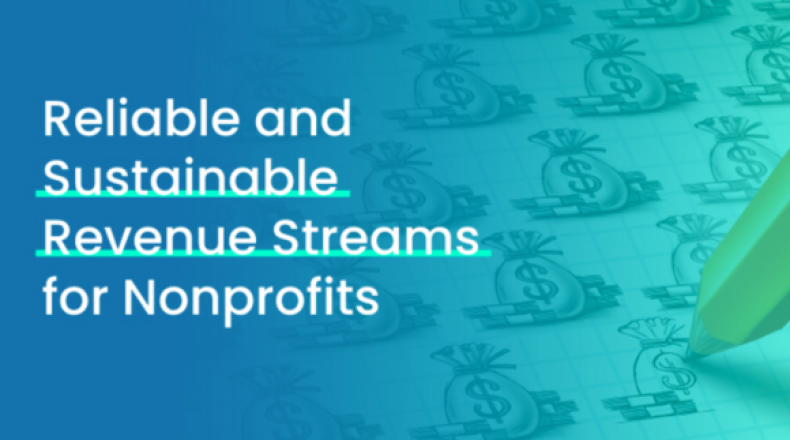4 Reliable and Sustainable Revenue Streams for Nonprofits

Sustainable revenue is essential for your nonprofit to thrive. It requires less staff time, boosts your organization’s growth and capacity, and allows you to make an even greater impact on your beneficiaries. When you aren’t spending all of your time worrying about where your next funds will come from, you’ll have more bandwidth for the other important aspects of nonprofit governance.
Let’s take a closer look at four sustainable revenue streams your nonprofit may be able to leverage to reliably secure the funds for your growing organization.
1. Recurring giving program
While gifts from individual donors likely make up a large portion of your fundraising efforts, not all of these contributions are sustainable. After all, your nonprofit probably receives plenty of one-time donations from individuals who never interact with your organization again.
For a more sustainable approach to donations, implement a recurring giving program. Usually, these programs invite donors to turn their one-time gifts into monthly, quarterly, or annual donations instead. This provides you with a more reliable stream of revenue.
To successfully get donors to adopt recurring giving, encourage them to do so by:
- Simplifying the process. Add a recurring giving option to your online donation form to make it easy for donors to opt in.
- Offering tiered giving levels. Include recommended giving amounts to simplify the decision even further. Also, allow donors to customize their giving frequency.
- Providing exclusive benefits. Send recurring donors a monthly newsletter with behind-the-scenes information, invite them to exclusive events, and provide other exclusive benefits to incentivize supporters to make recurring gifts.
Additionally, be sure to recognize and show appreciation to recurring donors beyond just a simple donation receipt. Even if their individual gifts aren’t large, the fact that they’ve agreed to take part in your recurring giving program means that they’re passionate about your cause. On top of the exclusive benefits they receive, you might also feature their names in special marketing messages or create a dedicated recurring donor wall to recognize them publicly and inspire other supporters to join the program.
Recurring giving can also result in more funds for your nonprofit. The average monthly gift is $24, resulting in an annual donation total of $288, which is greater than the average one-time gift of $115. Plus, with the average recurring donor lifetime lasting just over eight years, it’s clear that this is a truly reliable avenue for your nonprofit to generate funds.
2. Merchandise shop
If you’ve ever purchased a t-shirt branded to your local animal shelter or for your university’s annual 5K run, then you’ve participated in a merchandise sale. Usually, these sales are held to commemorate or maximize revenue at a specific event, but nonprofits can also set up long-term merchandise shops where they sell various items and apparel branded to their organization.
This sustainable revenue stream is particularly popular for these kinds of nonprofits:
- Educational institutions, such as schools and universities
- Arts and cultural organizations, such as museums, aquariums, and zoos
- Environmental and sustainability causes
- Animal shelters and rescue organizations
- Community development and youth centers
- Religious organizations
However, that doesn’t mean that only these types of nonprofits can host merchandise sales. As long as you’re willing to sell items at your nonprofit’s physical location or online, you can benefit from this revenue stream. Start small by just stocking a few types of merchandise to sell, such as t-shirts and mugs. Then, as you generate more revenue from this source, you can invest in a dedicated shop and even a point of sale (POS) system to make selling a wider variety of inventory even easier.
Plus, you’re not limited to just selling items related to your cause. General items such as snacks and drinks are also great crowd-pleasers, making them a great addition to your store. With proper planning and strategy, this type of revenue stream can be very profitable even despite the upfront investment.
3. Thrift stores
Although thrift stores likely aren’t one of the first fundraising ideas you’d think of, they’re still a great sustainable revenue source for nonprofits. These stores work very similarly to merchandise stores but with one key difference: instead of purchasing merchandise to sell, you accept in-kind donations of goods from community members and sell those in your store.
Thrift stores offer several benefits to nonprofits, including:
- Opportunity for support. For supporters who want to spring clean or who may not have the financial means to donate money to your nonprofit, a thrift store presents another way for them to make an impact on your mission. Plus, in-kind donations are tax-deductible, making this an appealing option for all.
- Discounted items. Thrift stores are extremely popular because they offer good-condition items for a much cheaper price than retail stores. This means that you’ll have plenty of community members shopping for your offerings.
- Community engagement. A store gives your nonprofit another chance to engage your community and educate them about your mission. And, if supporters have a positive interaction at your store, they’re more likely to continue to engage with your nonprofit.
Though setting up a thrift store is complicated and requires an upfront investment, it can be well worth it, even for nonprofits with unrelated causes. Consider Goodwill, for example. As a nonprofit, its mission is to reduce barriers to employment. However, it has become extremely well-known for its thrift stores, which allow it to generate funds and offer job opportunities to individuals with disabilities or other barriers to employment.
4. Matching gifts
While sponsorships are the best-known corporate philanthropy opportunity initiative, they’re not always reliable, as they’re dependent on a specific initiative like an event or a capital campaign. However, there are plenty of other, more sustainable corporate philanthropy programs that your nonprofit can leverage—most notably, matching gifts.
Matching gifts are donations that companies make when their employees also make a donation to a nonprofit. This is how they usually work:
- An employee makes a donation to a nonprofit.
- The nonprofit sends the employee a donation receipt, thanking them and suggesting that they apply for a donation match through their employer.
- The employee applies for a matching gift, including their donation receipt as proof that the donation was made.
- Their employer contacts the nonprofit to verify that the donation was made.
- The employer makes a donation to the nonprofit, matching the employee’s donation at a 1:1 ratio.
With matching gifts, your nonprofit can effectively double the donations it receives from eligible supporters. This is an extremely impactful revenue source that many supporters will be willing to apply for, as it costs them no extra money.
The main barrier nonprofits face in securing matching funds is awareness. With an estimated $4-7 billion in matching gift funds going unclaimed per year, it’s clear that this is an opportunity that needs more visibility among donors.
To solve this problem, directly promote matching gifts in email newsletters, social media posts, and on your website. Highlight it as an opportunity to generate more impact for your organization at no cost to the donor, and add a link to a dedicated matching gifts page that explains the entire process.
________________________________________________________________________________________________________________________________
Give your fundraising team a rest and allow them to spend time improving your organization’s larger giving initiatives by investing in sustainable ongoing revenue sources. With these ideas, your nonprofit can boost your funding significantly and begin looking toward securing your organization’s future with proper financial stewardship.
 Kyle Payton is the general manager of ThriftCart, an all-in-one point-of-sale product assisting nonprofits and small businesses in navigating the complexities of retail.
Kyle Payton is the general manager of ThriftCart, an all-in-one point-of-sale product assisting nonprofits and small businesses in navigating the complexities of retail.

